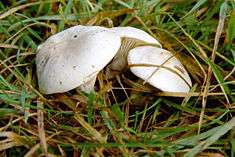Clitopilus prunulus
| The Miller | |
|---|---|
 | |
| Scientific classification | |
| Kingdom: | Fungi |
| Division: | Basidiomycota |
| Class: | Agaricomycetes |
| Subclass: | Hymenomycetes |
| Order: | Agaricales |
| Family: | Entolomataceae |
| Genus: | Clitopilus |
| Species: | C. prunulus |
| Binomial name | |
| Clitopilus prunulus (Scop. ex Fr.) P. Kumm. | |
| Synonyms | |
|
Agaricus prunulus Scop., 1772 | |
| Clitopilus prunulus | |
|---|---|
|
| |
| gills on hymenium | |
| cap is convex | |
| hymenium is decurrent | |
| stipe is bare | |
| spore print is pink | |
| ecology is saprotrophic | |
| edibility: choice | |
Clitopilus prunulus, commonly known as the miller or the sweetbread mushroom,[1] is an edible pink-spored basidiomycete mushroom found in grasslands in Europe and North America. Growing Solitary to gregarious in open areas of conifer/hardwood forests; common under Bishop pine (Pinus muricata) along the coast north of San Francisco; fruiting shortly after the fall rains. It has a grey to white cap and decurrent gills.
Taxonomy
Tyrolean naturalist Giovanni Antonio Scopoli described the miller as Agaricus prunulus in 1772. German botanist Paul Kummer gave the miller its current name in 1871.[2]
Description
The cap is initially convex when young, but in maturity flattens out, usually with a shallow central depression. It is white or light gray or yellow, sticky when moist, and 3 to 10 cm (1.2 to 3.9 in) in diameter with a characteristic feel to the touch of chamois skin. The gills are decurrent in attachment to the stipe, spaced together rather closely, and whitish, although they often develop a pinkish hue in age. The stipe is 3 to 8 cm (1.2 to 3.1 in) long × 4–15 mm thick, and white. This mushroom has a mealy odor, somewhat like cucumber.[3] The spore print is pink. Spores are 9–12 × 5–6.5 µm.[4] C. prunulus may be found growing on the ground in hardwood and coniferous woods in the summer and fall.
The variant C. prunulus var. orcellus has a slimy cap and white colors.
Volatile compounds
The cucumber odor of this species has been attributed to trans-2-nonenal, which is present at a concentration of 17 µg per gram of crushed tissue.[3] C. prunulus contains the volatile compound 1-octen-3-ol, making it unpalatable to the coastal Pacific Northwest banana slug, Ariolimax columbianus.[5]
Similar-looking species
The poisonous Clitocybe rivulosa (fool's funnel) looks similar. The miller has pink spores whereas fools funnel are white, the gills of the miller are more easily pulled away, and the miller smells of raw pastry. The miller also prefers woodland whereas fool's funnel is a grassland species.[6]
References
- ↑ "Clitopilus prunulus (MushroomExpert.Com)". Retrieved 2009-01-20.
- ↑ Kummer, Paul (1871). Der Führer in die Pilzkunde (in German) (1 ed.). Zerbst, Germany: Luppe. p. 97.
- 1 2 Wood WF, Brandes ML, Watson RL, Jones RL, Largent DL. (1994). trans-2-Nonenal, the cucumber odor of mushrooms. Mycologia 86(4): 561–563.
- ↑ Rosanne A. Healy; Huffman, Donald R.; Lois H. Tiffany; George Knaphaus (2008). Mushrooms and Other Fungi of the Midcontinental United States (Bur Oak Guide). Iowa City: University of Iowa Press. p. 75. ISBN 1-58729-627-6.
- ↑ Wood WF, Archer CL, Largent DL. (2001). 1-Octen-3-ol, a banana slug antifeedant from mushrooms. Biochemical Systematics and Ecology 29(5): 531–533.
- ↑ John Wright (2007). River Cottage Handbook No.1 Mushrooms. London: Bloomsbury Publishing PLC. ISBN 978-0-7475-8932-7.
External links
| Wikimedia Commons has media related to Clitopilus prunulus. |